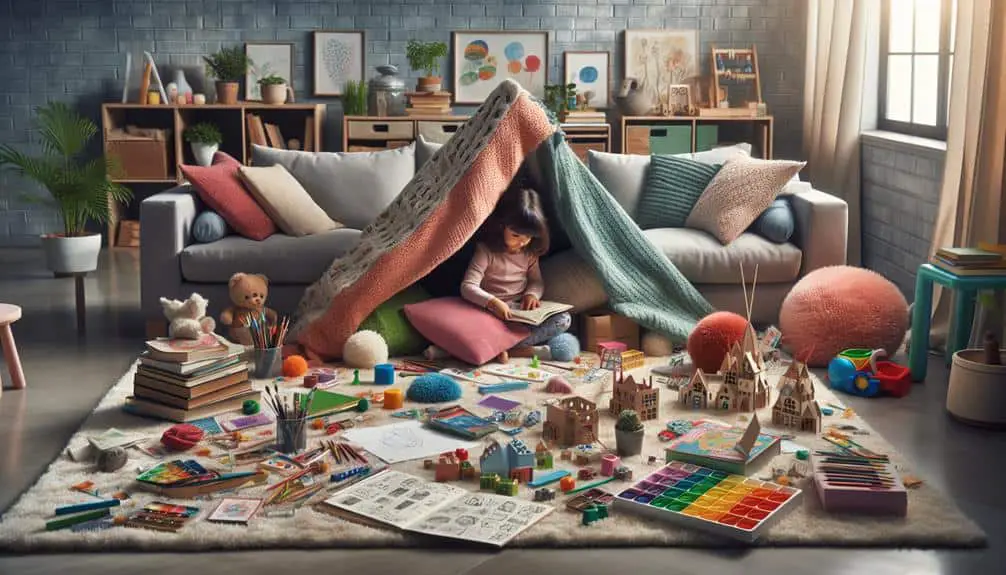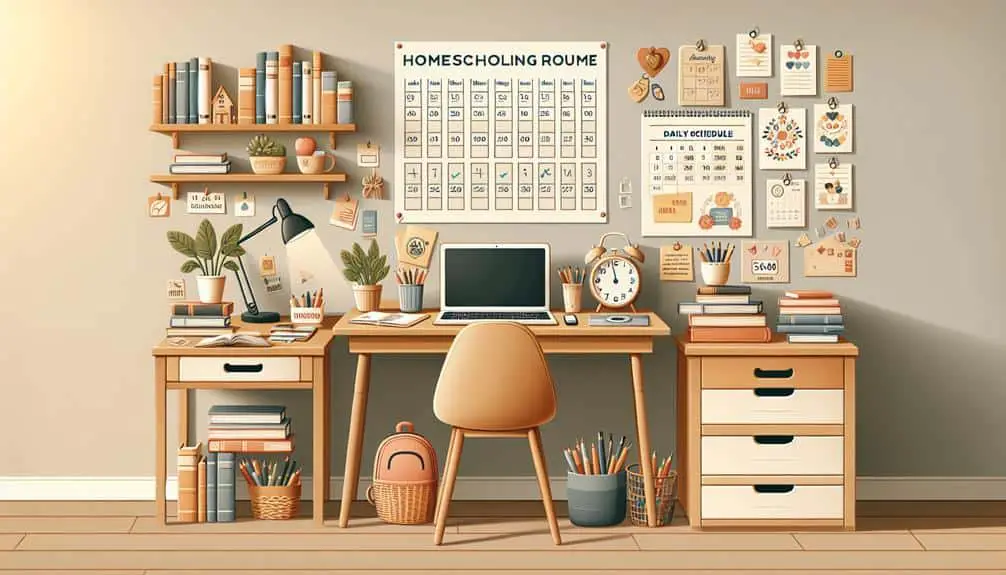Awaken your child's boundless potential by nurturing imagination at home. Encourage creativity, critical thinking, and problem-solving skills through imaginative play and storytelling. Create a stimulating environment filled with diverse materials for exploration. Foster innovation and adaptability while boosting confidence in tackling challenges. Cultivate curiosity through hands-on activities that ignite a passion for discovery. Strengthen family bonds and promote self-expression through collaborative art projects. Spark creativity, enhance problem-solving abilities, and inspire wonder in young minds. Start your journey to fostering imagination at home and witness the incredible growth and development it brings.
Key Points
- Create a creative environment at home to inspire imaginative play and exploration.
- Engage in playful learning activities to foster creativity and critical thinking skills.
- Encourage family involvement in artistic projects and storytelling adventures.
- Provide diverse materials for hands-on exploration and experimentation.
- Cultivate curiosity through interactive experiences and problem-solving challenges.
Benefits of Nurturing Imagination at Home
Nurturing imagination at home fosters creativity, critical thinking, and problem-solving skills in children, laying a strong foundation for their future success. By encouraging your child to explore their imagination through activities like storytelling, drawing, or imaginative play, you're actively developing their creativity. This creativity won't only manifest in artistic pursuits but will also enhance problem-solving abilities.
When children engage in imaginative play, they learn to think outside the box, come up with innovative solutions, and adapt to new situations.
Moreover, by fostering imagination at home, you're providing your child with a safe space to experiment, make mistakes, and learn from them. This process of trial and error is vital for enhancing problem-solving skills. When children are encouraged to explore their ideas freely, they become more confident in their abilities to tackle challenges and find creative solutions.
Ultimately, nurturing imagination at home sets the stage for a lifetime of creativity and effective problem-solving.
Setting the Stage for Creativity
To cultivate a creative environment at home, consider incorporating a variety of stimulating activities that encourage exploration and imagination. Creative environments are essential for nurturing creativity in children. Providing spaces where they can engage in imaginative play allows them to express themselves freely and develop essential skills.
Stimulating creativity through art, storytelling, or even outdoor adventures can inspire wonder and curiosity in young minds. Creating a setting that fosters creativity involves offering diverse materials and resources that encourage experimentation. Simple things like art supplies, building blocks, or even nature walks can spark innovative thinking and problem-solving abilities.
Incorporating Play Into Learning
Get ready to infuse a sense of fun and exploration into your home education journey by incorporating play into learning.
Discover a range of playful learning activities that can engage and educate your child in exciting ways.
Uncover the numerous benefits of play-based education and explore resources that can help you seamlessly integrate play into your child's learning experience.
Playful Learning Activities
Incorporating play into learning can greatly enhance your child's educational experience by fostering creativity and critical thinking skills. Engaging your child in imaginative adventures and hands-on exploration can make learning more enjoyable and effective.
Activities such as sensory play, where children use their senses to explore materials like sand, water, or playdough, can help develop cognitive skills and enhance their understanding of the world around them.
Interactive storytelling is another fantastic way to combine play and learning. By encouraging your child to act out stories, create their own narratives, or engage in role-playing, you're promoting language development, imagination, and problem-solving abilities.
Playful learning activities not only make education fun but also allow children to learn in a way that feels natural to them. Through these interactive and engaging experiences, children can develop a love for learning that will stay with them throughout their lives.
Benefits of Play
Engage your child's natural curiosity and learning potential by infusing play seamlessly into their educational journey. Play is a powerful tool that can enhance your child's cognitive development and creativity, making learning a fun and engaging experience.
Here are three key benefits of incorporating play into your child's education:
- Role playing games & imaginative storytelling: Encourage your child to create their narratives, explore different characters, and immerse themselves in imaginary worlds. This fosters language development, social skills, and problem-solving abilities.
- Outdoor exploration: Take learning outside by engaging in nature walks, scavenger hunts, or simply playing in the backyard. Outdoor play enhances physical health, stimulates the senses, and promotes a deeper connection with the natural world.
- Sensory play: Engaging in activities that involve different textures, smells, and sounds can help your child build neural connections, develop fine motor skills, and enhance their understanding of the environment around them. Incorporating sensory play can be as simple as playing with sand, water, or even homemade playdough.
Play-Based Educational Resources
Explore a variety of play-based educational resources to seamlessly integrate learning through engaging and interactive activities. Imaginative play is a powerful tool for children's development, fostering creativity, problem-solving skills, and social interactions. Educational toys such as building blocks, puzzles, and role-playing sets can enhance cognitive abilities while keeping the learning process enjoyable.
Encourage creative exploration by providing materials for arts and crafts projects, allowing children to express themselves through painting, drawing, and sculpting. These activities not only boost artistic skills but also promote fine motor skills and hand-eye coordination.
Sensory activities like sensory bins filled with different textures, scents, and colors can stimulate a child's senses, supporting cognitive growth and emotional regulation.
Engaging in Creative Projects Together
Get ready to start on a journey of creativity and collaboration by delving into various engaging projects with your homeschooling team. Engaging in creative projects together not only fosters imagination but also strengthens bonds within the family unit.
Here are three exciting ways to spark creativity and inspire learning through hands-on activities:
- Artistic Experiments: Encourage your homeschooling team to explore different art forms and techniques. From painting and sculpting to mixed media creations, artistic experiments allow children to express themselves freely while developing their fine motor skills and creativity.
- Storytelling Adventures: Immerse yourself in the world of storytelling by creating your own narratives or reimagining classic tales. Let your imagination run wild as you craft characters, settings, and plotlines together. Storytelling adventures not only enhance language skills but also nurture a love for creativity and literature.
- DIY Projects: Engage in do-it-yourself projects that challenge your team to think critically and problem-solve. Whether it's building a birdhouse, designing a cardboard castle, or crafting homemade instruments, DIY projects encourage innovation and hands-on learning through imaginative play.
Cultivating Curiosity Through Exploration
Explore the wonders of cultivating curiosity through exploration, igniting a passion for discovery and learning within your homeschooling team.
Encouraging creative play and curiosity exploration can open doors to endless possibilities. Engage in hands-on activities that spark imagination and foster a sense of wonder in your children.
Create a nature scavenger hunt where your children can discover the beauty of the outdoors while honing their observation skills. Encourage them to ask questions, investigate, and seek answers independently. Through this process, they'll develop critical thinking skills and a thirst for knowledge.
Utilize resources such as science kits, puzzles, or DIY projects to provide opportunities for hands-on exploration. Allow your children the freedom to experiment, make mistakes, and learn from them. This won't only cultivate their curiosity but also boost their confidence and resilience.
Encouraging Self-Expression and Innovation
Encourage your homeschooling team to embrace self-expression and foster innovation through engaging activities that nurture creativity and originality. By incorporating artistic exploration and imaginative storytelling into your curriculum, you can inspire your children to think outside the box and express themselves in unique ways.
Here are three ways to encourage self-expression and innovation:
- Hands-On Projects: Encourage your children to engage in hands-on projects that allow them to experiment, create, and innovate. Whether it's building a model, crafting a piece of art, or conducting a science experiment, hands-on projects give children the freedom to express themselves creatively.
- Creative Expression: Provide opportunities for your children to express themselves creatively through various mediums such as writing, painting, music, or drama. Encourage them to explore different forms of creative expression to find what resonates with them the most.
- Collaborative Innovation: Foster a collaborative environment where children can bounce ideas off each other, work together on projects, and inspire innovation through teamwork. Collaborative innovation not only encourages self-expression but also teaches children the value of sharing ideas and working towards a common goal.
Frequently Asked Questions
How Can I Balance Fostering Imagination With Academic Learning?
Balancing fostering imagination with academic learning might seem like juggling flaming swords, but fear not! Encourage creative play alongside structured lessons to blend imagination integration with academic success seamlessly. Embrace the chaos!
What Are Some Ways to Encourage Imaginative Thinking in Teenagers?
To encourage imaginative thinking in teenagers, engage them in creative activities like art projects and role-playing games. Incorporate mindfulness exercises to help them tap into their inner creativity, fostering a holistic approach to imagination development.
Can Fostering Imagination at Home Help With Social Skills Development?
Fostering imagination at home can greatly help with social skills development. When you encourage creativity and imaginative thinking, you're also promoting emotional intelligence. These skills enhance social interaction, allowing for deeper connections and better communication.
Are There Specific Techniques for Nurturing Creativity in Introverted Children?
To nurture creativity in introverted children, engage in creativity exercises like art therapy. Encourage quiet play and mindfulness activities to spark imagination. These techniques help introverted kids express themselves creatively and develop their artistic skills.
How Do I Handle Resistance to Imaginative Activities From My Child?
When your child resists imaginative activities, offer creative incentives and establish understanding boundaries. Encourage them to explore at their pace, building confidence in their own creative expression. Patience and support will help them embrace creativity.



